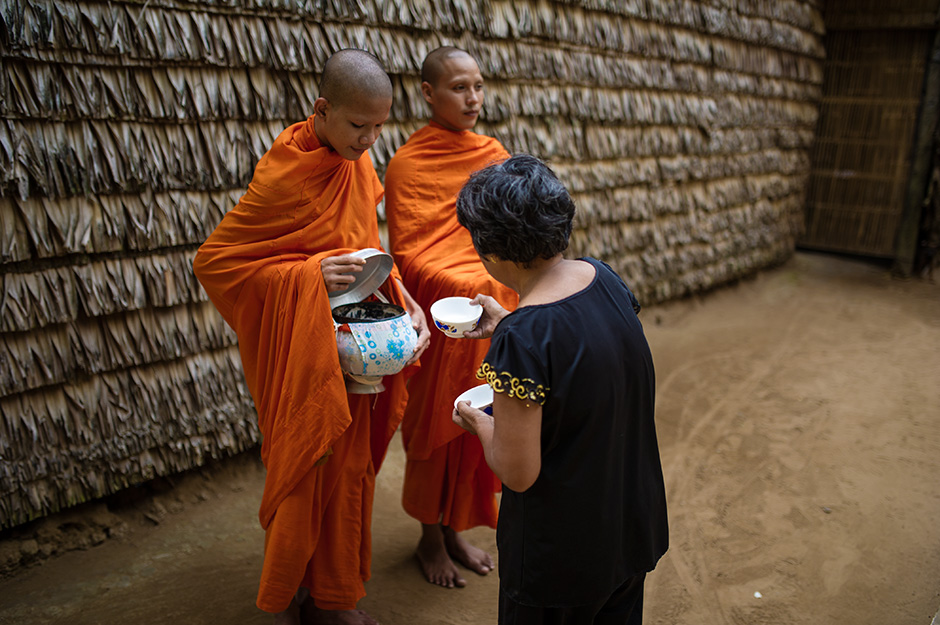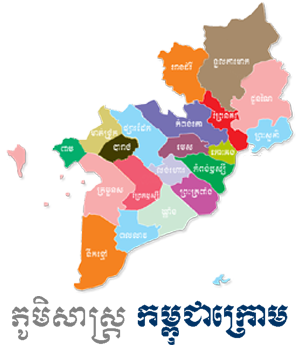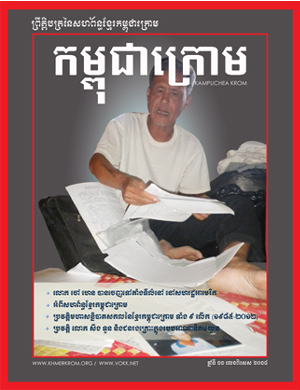By Micheal Huff
Once, very far away and very long ago, a powerful king from the West met a wise monk from the East. To test the monk’s wisdom, the king posed many difficult questions: Why do good people sometimes suffer while evil people sometimes prosper? How can we know what truth is? How can there be rebirth without an eternal soul ? He asked many such questions. To each, the monk answered with brilliance and serenity. After their talk, the king left his throne and joined the monk in teaching the Middle Way.

The Khmer Krom are a discriminated minority living in the Southern Vietnam, in the heart of the Mekong Delta, once part of the Khmer Empire. It’s amazing how they keep up their culture with an unbelievable pride despite being continually harassed by the Vietnamese government. Credit: Marco Bottigelli
This conversation of 2,000 years ago between the Bactrian King Menander and the Buddhist monk Nagasena was recorded in the Milindapanha, or The Questions of King Milinda. Today, this classic text of Theravada Buddhist literature is yearly brought to life in the ethnic Khmer villages of Vietnam’s Mekong Delta. During the New Year celebration in April, one monk from a local temple will take the role of Menander, another that of Nagasena, and the two will recreate parts of the discourse for the Khmer community.
Within this traditional culture the monks are the spiritual leaders of their society, and as such they take on many roles. Storytelling is but one of the many responsibilities of these ochre-robed men. Others include teaching the Khmer writing system to the community’s children and young adults, preserving manuscripts in their monasteries, and collecting Khmer language print materials. As scholars, the monks have been given cause to reflect on the state of intellectual freedom in the recent political milieu of Southeast Asia. And finally, the digital information revolution has excited the curiosity of some of the monks, who recognize its potential promise. Insofar as they act as the information providers for their community, Khmer monks share many of the same duties and concerns held by the library profession around the globe.
Since October 1997, I have had the opportunity to explore a part of the world of international librarianship in the homeland of the ethnic Khmer. Working as an ALA Library Fellow at Can Tho University, in the heart of the Mekong Delta, I have been assisting my Vietnamese colleagues in designing and implementing a library automation system and network, tasks that are much the same as my responsibilities at the Central Rappahannock Regional Library in Fredericksburg, Virginia. What expertise I have had to offer to the Vietnamese librarians has been enthusiastically received, and in return I have come to know as friends some of the most gracious and courageous people I have ever met in my life. The experience has been nothing short of extraordinary.
The richness of this adventure grew even greater when I became acquainted with the Khmer monks of Wat Muniransyarama, the Temple of Light. Since I became their next-door neighbor in downtown Can Tho, I have since spent many evenings in their company, sipping tea and learning about the Khmer way of life. Some of the monks and many of the Khmer students who attend the university study and speak English. Given their eagerness to improve their listening and speaking skills, I am never without opportunity to engage them in conversation. Through my talks with the monks and the laity and through my observations of their roles, I have been given much to reflect on regarding service to one’s community.
The ethnic Khmer are the indigenous people of the Mekong Delta and Cambodia. Estimates of their population in Vietnam vary from between 1 to 3 million. Though the Vietnamese did not begin settling in this region until the 17th century, there are some Khmer settlements that have been continuously occupied since at least the 11th.
An agricultural society, the Khmer are known for being skillful rice farmers.
At the center of all Khmer communities is the wat, both temple and monastery of Theravada Buddhism. By supporting the wat’s monks, the laity contributes to the making and sharing of communal merit; the monastery in turn serves the community, in part by serving as a center of learning.
As religious practitioners and scholars, Khmer Buddhist monks have faced much persecution and suppression in recent history. During the brutal reign of Pol Pot in the late 1970s, Cambodian monasteries were destroyed or desecrated, and monks were murdered or forced to leave the order. Some of the greatest collections of Buddhist literature in the world were burnt or otherwise destroyed by the Khmer Rouge.
In Vietnam from 1975 until 1986, the government actively suppressed the practice of religion, and many leaders of all faiths were sent to re-education camps. However, since 1986 the Vietnamese government has eased its social restrictions, and once again the wat are openly acting as the vital centers of the Khmer communities throughout the Mekong Delta.
Before 1975, over 100 monks were associated with Wat Muniransyarama. Today there are only 10, most of whom have joined the order in the past decade. Their work begins at 5 a.m. when they rise for prayer and meditation. The majority of the rest of their day is devoted to study, teaching, and the performance of sacred rites within the Khmer community. A central part of all of these activities is the wat library.
To the side of the central shrine room, some simple wooden shelves with glass doors house just fewer than 100 volumes and manuscripts. Though small in size, the collection is vast in significant content. Its core is the Pali Canon, the complete scripture collection of Theravada Buddhism. Preserved in its original language, this collection is also known as the Tripitaka, or Three Baskets, referring to its three sections: Vinaya Pitaka, the Basket of Discipline, or rules of monastic conduct; Sutta Pitaka, the Basket of Discourse, or the dialogues and teachings of the Buddha; and Abhidharma Pitaka, the Basket of Higher Teachings, or Buddhist metaphysics.
Through the access provided by the monks, the teachings in these books, written in both Pali and in Khmer transliteration, have provided guidance to the Khmer community for many centuries. The collection also consists of a number of palm-leaf manuscripts. The format of these documents is unique to this region of the world. Using techniques developed in Burma, a monk will write a verse or teaching from Buddhist scripture on pieces of dried sugar-palm leaf that measure about a foot long and two inches wide. A metal stylus is used to inscribe the text on the leaf, breaking the layer of cutin. Dye is then wiped across the leaf, staining the incised letters. Not only is the work exacting manually, but the monk also uses an archaic script when transcribing the text in this manner. In a day’s time, a monk may only be able to complete two leaves. Each leaf is pierced through the center, and the completed manuscript of 20 to 30 leaves is bound by a single loose loop of string. Often used in sacred rites or healing ceremonies, these handwritten texts help to preserve an ancient art and an enduring way of life.
Another concern of the monks is literacy among the Khmer people. Teaching the skills of reading and writing to Khmer children is recognized as essential to the preservation of their culture in Vietnam. According to statistics compiled by UNESCO in 1990, only 36% of the Khmer population in Cambodia was literate. While many Khmer in the Mekong Delta can read and write in Vietnamese, it is only through the efforts of the monks that literacy in their mother tongue is being promoted outside of the monastic community.
Proscribing Print
One obstacle to accomplishing this goal is the acquisition of new Khmer print materials. While the Vietnamese Ministry of Culture and Information publishes some materials in the Khmer language, it also requires a lengthy review process for any materials imported from Cambodia. According to the government, this effort is to prevent “cultural materials unsuitable to Vietnamese society” from entering the country. The bureaucracy involved in the review process effectively deters anyone from trying to import print materials legally, and the situation has left the monks vexed.
Though it would also involve some red tape, local publication of documents in Khmer script is a possible solution. Even so, the problem remains of where to find a Khmer typesetter. After the monks mentioned this dilemma to me, I e-mailed my colleague Chris Glover of the Central Rappahannock Regional Library in Virginia, and asked him to see what he could find in the way of freeware Khmer fonts on the Web.
Within a few days I had the makings of a Khmer desktop publishing outfit on my laptop. Soon I was teaching basic word processing at the wat in the evening. Some of the monks had already learned basic computer skills at local schools, but everything had been done in Vietnamese. Not only have we worked on the design and editing of documents in Khmer, we have also begun to explore the creation of online hypertexts as a way of indexing the collection in the wat library.
In teaching the monks, I have also become their student. With their help, I am learning both the Khmer script and the fundamentals of conversation. That many of the monks can speak in Khmer, Pali, Vietnamese, English, and French has both humbled and inspired me. They are determined to teach not only their community, but like Nagasena with Menander they wish also to provide Westerners with information about Theravada Buddhism. They too understand the need for a global reach and that it can be attained through a local touch. It is all part of their commitment to service.
Even an ethnic minority community in one of the most economically disadvantaged regions of the world has the equivalent of the local library. The Khmer people support the wat, and part of what they get back is the assurance that the knowledge about their ways of life will be maintained and made available to them. Telling ancient stories, preserving manuscript archives, teaching literacy skills, discussing intellectual freedom, learning diverse languages, and exploring new information technologies are all some of the ways the of War Muniransyarama fulfill their obligation.
When Nagasena met Menander, every question had its answer. As Ranganathan invited our profession to remember, every book has its reader. Whether we work for municipalities or universities or law firms or hospitals or public schools, to bring our communities together with the information they seek is the responsibility we are called upon to fulfill.
Amidst all of the technological change and management issues and budget battles, this call to service is what unites our profession. As long as we never lose sight of this goal, I believe we need not worry about obsolescence; after all, service to their communities has sustained the Theravada order of Buddhist monks for 2,500 years.
Sources: http://ccbs.ntu.edu.tw













